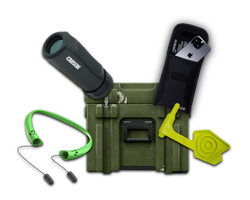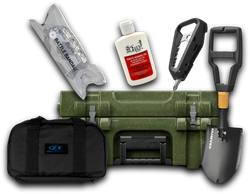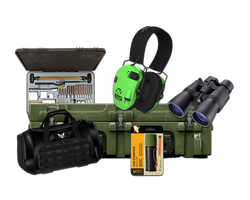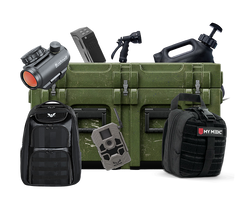How to Zero a Thermal Scope: A Comprehensive Guide
Table of Contents
- Introduction
- Why Zeroing a Thermal Scope is Important
- Tools and Materials Needed for Zeroing
- Methods for Zeroing a Thermal Scope
- Tips for Successful Zeroing
- Conclusion
- FAQ
Introduction
For those stepping into the world of thermal optics, the thrill of night hunting or surveillance is often accompanied by a steep learning curve. One of the most vital skills in this realm is knowing how to zero a thermal scope effectively. Imagine standing in the dim light of dusk, your rifle poised, but your shots are missing the mark. It can be frustrating. Did you know that improperly zeroed optics can lead to a staggering 20% reduction in accuracy? Such a loss could mean the difference between a successful hunt and coming home empty-handed.
Understanding how to zero a thermal scope is not just a technical skill; it's an essential part of ensuring your readiness for any tactical situation. With advancements in thermal imaging technology, the methods and tools available for zeroing have evolved, making it easier yet more complex than ever before. This post aims to unravel the intricacies of zeroing a thermal scope, providing you with actionable insights and tips to achieve accuracy every time you take aim.
By the end of this guide, you will have a thorough understanding of the techniques, tools, and considerations necessary for zeroing your thermal scope. Whether you are a novice looking to get started or an experienced user seeking to refine your skills, this article will serve as a valuable resource. We’ll explore the reasons why zeroing is crucial, the specific methods you can employ, and tips for achieving consistent results.
Let’s dive deep into the world of thermal optics, ensuring that you leave this guide equipped with the knowledge to enhance your shooting precision.
Why Zeroing a Thermal Scope is Important
Understanding Zeroing
Zeroing is the process of aligning your scope's reticle with the point of impact (POI) of your shots. For thermal scopes, this alignment is crucial due to the unique way they detect heat rather than visible light. Unlike traditional scopes, which can rely on common paper targets, thermal scopes require special attention to the heat signatures of your targets.
The Impact of Poor Zeroing
A misaligned thermal scope can result in significant discrepancies between your point of aim (POA) and POI. This could lead to missed opportunities in critical situations, whether during hunting, tactical operations, or surveillance. Zeroing ensures that your shots are accurate, thus optimizing your effectiveness in the field.
Situational Awareness
In tactical scenarios, where every shot counts, understanding how to properly zero your thermal scope enhances your situational awareness. It allows you to focus on your target without the distraction of adjusting for misalignment. This heightened focus can be the difference in high-pressure situations.
The Benefits of Proper Zeroing
- Enhanced Accuracy: Ensure your shots land where you intend.
- Increased Confidence: Gain peace of mind knowing your setup is optimized.
- Improved Tactical Efficiency: Save time and ammunition by reducing the need for adjustments in the field.
Tools and Materials Needed for Zeroing
Before you can zero your thermal scope, you will need to gather some essential tools and materials. Each method may require different items, so be prepared with a variety of options.
Basic Tools
- Rifle with Thermal Scope: Ensure your rifle is equipped with a quality thermal scope that meets your needs.
- Shooting Bench or Rest: A stable surface is critical for precision shooting.
- Target Board: Use a material that allows for clear visibility of hits; options include foam board, cardboard, or metal.
- Firearm Safety Gear: Always prioritize safety with glasses and hearing protection.
Targeting Aids
- High Contrast Targets: Use black duct tape or self-adhesive foil tape to create high contrast points on your target board.
- Heating Elements: Items like hand warmers or heated screws can serve as effective aiming points.
- Reflective Materials: Aluminum foil can reflect heat well, making it easier to see through your thermal scope.
Optional Tools
- Laser Range Finder: For precise distance measurement.
- Wind Meter: Understanding wind conditions can help in long-range shooting.
Methods for Zeroing a Thermal Scope
Now that you have your tools ready, let's explore the various methods for zeroing your thermal scope. Each technique has its advantages and considerations, so choose one that best suits your circumstances.
Method 1: Using Heated Screws
- Preparation: Gather a few screws and heat them using a lighter or torch.
- Target Setup: Attach a piece of white poster board to your target board. Insert one heated screw in the center.
- Aiming Point: Look through your thermal scope; the heated screw will appear as a bright point.
- Firing: Take a shot at the heated screw.
- Evaluate: After firing, insert a second heated screw into the bullet hole to create a second aiming point.
- Adjust: Use the two heated screws to align your reticle with the POI.
Method 2: Utilizing Hand Warmers
- Target Setup: Tape several hand warmers to your target board.
- Distance: Position the target at the distance you wish to zero—commonly 50-100 yards.
- Shooting: Fire at the warmers, which will show up distinctly through your thermal scope.
- Adjustments: Note where your shots hit relative to the warmers and adjust your scope accordingly.
Method 3: Foil Tape Targets
- Preparation: Cover a piece of cardboard with shiny aluminum foil tape.
- Contrast Creation: Create a high-contrast target by cutting shapes from black duct tape and applying them to the foil.
- Firing: Shoot at the target and observe where the bullets impact.
- Evaluation and Adjustment: Make necessary adjustments to align your reticle with the POI.
Method 4: Commercial Thermal Targets
For those who prefer a hassle-free approach, consider using commercially available thermal zeroing targets. These targets are designed specifically for thermal optics, offering clear visibility of hits.
- Purchase: Acquire thermal zeroing targets from reputable suppliers.
- Setup: Follow the manufacturer's instructions for setup, usually involving activating the target before use.
- Shooting: Fire at the target and adjust your scope based on the visible impacts.
Tips for Successful Zeroing
Choose the Right Time
For optimal visibility, consider zeroing during the day. This allows you to see the target clearly. If zeroing at night, ensure you have adequate artificial lighting to illuminate the target.
Distance Matters
Start zeroing at a distance where you feel comfortable. Most shooters prefer beginning at 50 yards, gradually moving to longer distances once comfortable with their setup.
Patience is Key
Zeroing a thermal scope can take time and multiple shots. Be patient and willing to make fine adjustments as necessary.
Document Your Settings
Keep a record of your zeroing settings. Note the distance, adjustments made, and conditions during your zeroing process. This can serve as a valuable reference for future adjustments.
Conclusion
Understanding how to zero a thermal scope is an essential skill that enhances your effectiveness in the field. By employing the various methods discussed and utilizing the proper tools, you can achieve a level of precision that boosts your confidence and performance.
Remember, the key to successful zeroing lies in preparation, patience, and practice. Whether using heated screws, hand warmers, or commercial targets, each method has its merits, and finding the one that works best for you is part of the journey.
As you continue to hone your skills, consider joining the Crate Club community for access to quality tactical gear and survival tools that can further empower your tactical endeavors. Explore our subscription services that cater to different levels of experience, from the Lieutenant tier for beginners to the General tier for seasoned professionals.
For those looking to shop for gear or expand their tactical arsenal, check out the Crate Club Shop.
Stay prepared, stay confident, and keep honing your skills. The night is yours to conquer.
FAQ
What distance should I zero my thermal scope?
The distance for zeroing your thermal scope typically ranges from 50 to 100 yards. Many shooters start at 50 yards to establish a baseline and make adjustments as needed.
Can I zero my thermal scope at night?
Yes, you can zero your thermal scope at night. Ensure you have sufficient lighting to illuminate your target, as thermal scopes rely on heat signatures.
What are the best materials for creating targets for thermal scopes?
High-contrast materials such as black tape on white backgrounds, aluminum foil, and heated objects like screws or hand warmers work well for thermal scopes.
How can I improve my accuracy when zeroing?
Patience, practice, and careful observation are key. Document your settings for future reference, and consider environmental factors such as wind and lighting conditions when zeroing.
Where can I find quality thermal scopes and gear?
For high-quality tactical gear and thermal optics, check out Crate Club for subscription services that fit your needs and access to a curated selection of top-tier equipment.
Share this article



